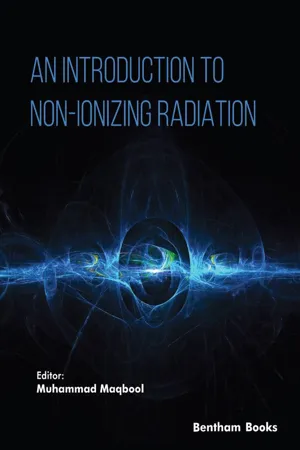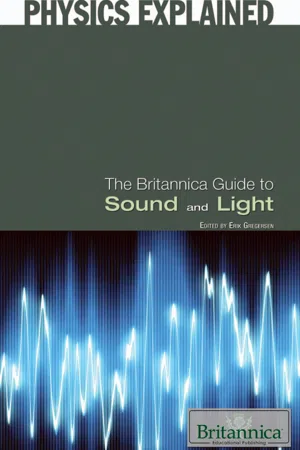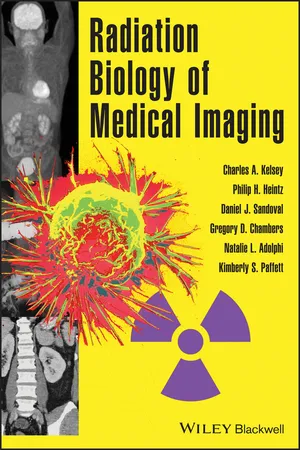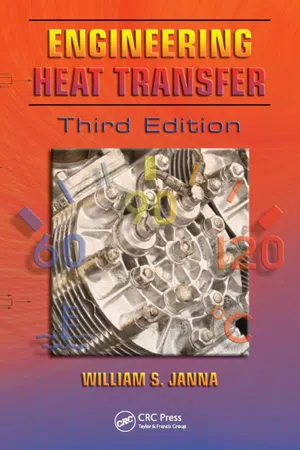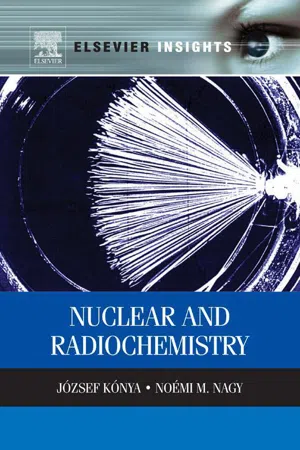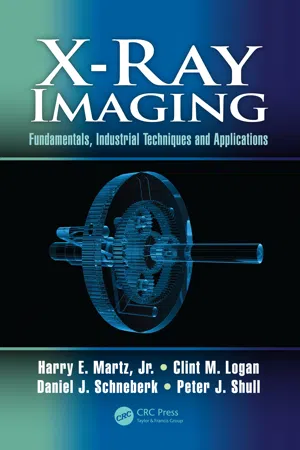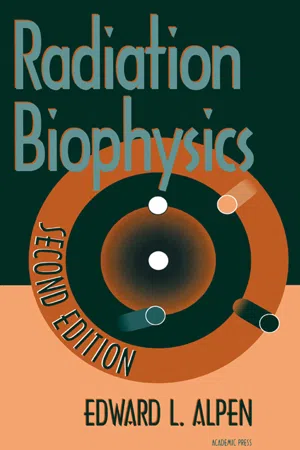Physics
Radiation
Radiation refers to the emission of energy in the form of waves or particles. In physics, it can encompass various phenomena such as electromagnetic radiation (e.g., light, radio waves, X-rays) and nuclear radiation (e.g., alpha, beta, and gamma radiation). Radiation plays a crucial role in understanding the behavior of matter and energy at the atomic and subatomic levels.
Written by Perlego with AI-assistance
Related key terms
Related key terms
1 of 4
Related key terms
1 of 3
9 Key excerpts on "Radiation"
- eBook - ePub
- Muhammad Maqbool(Author)
- 2000(Publication Date)
- Bentham Science Publishers(Publisher)
Radiation is a source of energy that originates from a source and travels through space or a medium. Upon interaction, Radiation may be able to penetrate, scatter, or be absorbed by materials. Radiation energy can be electromagnetic or particulate. In general, when people hear the word Radiation, they often think of nuclear power and radioactivity, and at the most, some people will pay attention to alpha (α) rays, beta (β) rays) and gamma (γ) rays), but Radiation has many other forms. Visible light is a familiar form of Radiation; other types include x-rays, ultraviolet Radiation, infrared Radiation (a form of heat energy), microwaves (used in microwave Owens at homes), and radio and television signals. Radiation may be obtained from various sources, including cosmic rays from the universe, and the earth, as well as man-made sources such as those from nuclear fuel and medical procedures. Radiation has been used in many industries, including diagnostic imaging, cancer treatment (such as Radiation therapy), nuclear reactorswith neutron fission, radioactive dating of objects (carbon dating), as well as material analysis. The biggest source, from which we get Radiation, is the sun. Radiation carries and transmits energy in the form of waves or particles. Radiation possesses benefits and harms at the same time if overexposure occurs [1 ].Though it possesses dual nature, Radiation with zero rest mass is generally considered a wave, and Radiation with some rest mass is considered a particle. X- rays, visible light and infrared rays all are waves. Electrons, protons, neutrons, and α-rays are particles since they possess rest mass.Radiation with zero rest mass (waves) is classified into two categories: Electromagnetic waves (or electromagnetic Radiation) and mechanical waves.Electromagnetic and Mechanical Waves
There are many types of waves, and although they all have things in common, there are also characteristics and behaviors that distinguish them from each other. The two major classifications of waves, based on their nature and characteristics, are called electromagnetic waves and mechanical waves [2 - eBook - ePub
- Britannica Educational Publishing, Erik Gregersen(Authors)
- 2010(Publication Date)
- Britannica Educational Publishing(Publisher)
CHAPTER 5 ELECTROMAGNETIC RadiationI n terms of classical theory, electromagnetic Radiation is the flow of energy at the universal speed of light through free space or through a material medium in the form of the electric and magnetic fields that make up electromagnetic waves such as radio waves, visible light, and gamma rays. In such a wave, time-varying electric and magnetic fields are mutually linked with each other at right angles and perpendicular to the direction of motion. An electromagnetic wave is characterized by its intensity and the frequency ν of the time variation of the electric and magnetic fields.GENERAL CONSIDERATIONS
In terms of the modern quantum theory, electromagnetic Radiation is the flow of photons (also called light quanta) through space. Photons are packets of energy h ν that always move with the universal speed of light. The symbol h is Planck’s constant, while the value of ν is the same as that of the frequency of the electromagnetic wave of classical theory. Photons having the same energy h ν are all alike, and their number density corresponds to the intensity of the Radiation. Electromagnetic Radiation exhibits a multitude of phenomena as it interacts with charged particles in atoms, molecules, and larger objects of matter. These phenomena as well as the ways in which electromagnetic Radiation is created and observed, the manner in which such Radiation occurs in nature, and its technological uses depend on its frequency ν. The spectrum of frequencies of electromagnetic Radiation extends from very low values over the range of radio waves, television waves, and microwaves to visible light and beyond to the substantially higher values of ultraviolet light, X-rays, and gamma rays.OCCURRENCE AND IMPORTANCEClose to 0.01 percent of the mass/energy of the entire universe occurs in the form of electromagnetic Radiation. All human life is immersed in it and modern communications technology and medical services are particularly dependent on one or another of its forms. In fact, all living things on Earth depend on the electromagnetic Radiation received from the Sun and on the transformation of solar energy by photosynthesis into plant life or by biosynthesis into zooplankton, the basic step in the food chain in oceans. The eyes of many animals, including those of humans, are adapted to be sensitive to and hence to see the most abundant part of the Sun’s electromagnetic Radiation—namely, light, which comprises the visible portion of its wide range of frequencies. Green plants also have high sensitivity to the maximum intensity of solar electromagnetic Radiation, which is absorbed by a substance called chlorophyll that is essential for plant growth via photosynthesis. - eBook - ePub
- Charles A. Kelsey, Philip H. Heintz, Gregory D. Chambers, Daniel J. Sandoval, Natalie L. Adolphi, Kimberly S. Paffett(Authors)
- 2013(Publication Date)
- Wiley-Blackwell(Publisher)
many more injuries and deaths each year than Radiation, we tend to fear the unknown. Most people have no experience with Radiation, beyond UV exposure from the sun and the occasional medical X-ray. Therefore, the average person is more frightened of Radiation than electricity, because the average person knows something about how electricity is used and controlled (e.g., it can be shut off with a switch, “live” wires can be insulated with a plastic coating). Some sources of Radiation (nuclear reactors, X-ray machines) can also be shut off, but the Radiation we most fear comes from radioactive materials (radioactive waste generated in nuclear power plants, nuclear materials in weapons). Although radioactive materials cannot be turned off, simple measures, such as the use of shielding materials and maintaining a safe distance, are very effective at avoiding harmful Radiation exposure.One good property of Radiation is that it is very easy to detect. Ionizing Radiation passing through air creates an electrical charge that is easy to measure. Many of our medical colleagues wish there were a meter or detector for common diseases, such as cancer or Alzheimer's, which was as sensitive and readily available as Radiation detectors.The details of how Radiation interacts with matter in general and biological matter in particular, will be the topic of later chapters. In this chapter, we will introduce the types of ionizing Radiation and discuss their characteristics. We will also introduce the units of measurement used to quantify Radiation.Types of Ionizing Radiation
There are two basic types of ionizing Radiation: EM Radiation and particulate Radiation. Briefly, EM Radiation involves the transmission of energy, but not mass. In contrast, particulate Radiation consists of subatomic particles having both mass and energy. Importantly, both EM and particulate Radiation with sufficient energy are capable of tearing electrons out of atoms or molecular bonds in matter.EM Radiation
EM energy has both wave- and particle-like characteristics. The wave description is more useful for describing EM energy propagating through space or a medium. Figure 3.1 illustrates the wave-like properties of Radiation. Like any traveling wave, a traveling EM wave will have a propagation speed (v, in units of m/s), a wavelength (λ, in units of m), and a frequency (f, in units of s−1 ). In a given medium, the speed is constant, so a wave with higher wavelength will have a lower frequency, where v = λf - eBook - ePub
- William S. Janna(Author)
- 2018(Publication Date)
- CRC Press(Publisher)
11 Introduction to Radiation Heat Transfer 11.1 IntroductionRadiation heat transfer is entirely different from heat transfer by conduction or convection. A material medium is not required for two objects to exchange heat by Radiation. Radiation is an electromagnetic mechanism by which energy is transported at the speed of light through regions that are devoid of substance. For a net radiant interchange of energy between two bodies to occur, there must be a temperature difference. Furthermore, the rate at which the radiant interchange occurs is proportional to the difference of the fourth powers of their absolute temperatures.Our objective in considering the Radiation mode is in being able to calculate an energy-transfer or a heat-transfer rate for various problems of interest. For a better understanding of our model for Radiation, it will be necessary to borrow from several different disciplines:1. Electromagnetic theory. Radiation can be treated mathematically as if it were a traveling wave that contains energy and exerts a pressure. This wave-like nature is described by using electromagnetic wave theory.2. Statistical mechanics. Radiant energy is transported over a range of wavelengths. Statistical mechanics helps to describe how this energy is distributed over the spectrum of wavelengths (i.e., whether most of the energy from the sun, for example, is radiated over a few wavelengths or over many wavelengths).3. Quantum mechanics. All substances radiate and receive radiant energy continuously. Associated with these processes are atomic and molecular activities that are modeled with the principles of quantum mechanics.4. Thermodynamics. Quantum mechanics gives a description of molecular processes associated with Radiation. Thermodynamics, on the other hand, gives a description of how bulk properties behave.The physics of Radiation will be discussed in this chapter. Definitions of basic concepts will be presented, and at times it will become easy to forget that our objective is to calculate a heat-transfer rate. The amount of information indigenous to the field of Radiation can be overwhelming. While this chapter presents definitions and laws that are important in Radiation, the next chapter deals with the calculation of Radiation heat-transfer rates. - eBook - ePub
Fundamentals of Radio Astronomy
Astrophysics
- Ronald L. Snell, Stanley Kurtz, Jonathan Marr(Authors)
- 2019(Publication Date)
- CRC Press(Publisher)
Chapter 2Propagation of RadiationI N this chapter we describe the interactions between light and matter that are needed to understand how light propagates through matter. As we will discuss in later chapters, we can use the framework developed here to predict the emission produced by an astronomical source and to determine how that Radiation might be altered by matter in space as it travels to our telescope. The process by which light propagates through a medium is called radiative transfer. We will discuss in Section 2.1 the transfer of Radiation in general, and then in Section 2.2 discuss radiative transfer in an ionized and magnetic medium.2.1Radiative TransferAlthough the interactions between light and matter occur on a microscopic scale, the photons pass through matter on a macroscopic scale. In this section we will produce a heuristic derivation of what is commonly called the equation of radiative transfer. We start this discussion by considering the ways in which matter can alter Radiation that passes through it. Once electromagnetic Radiation is emitted, if it passes through matter that matter can (1) absorb some of the Radiation, (2) emit more Radiation, (3) absorb, and then re-emit Radiation at a new frequency, or (4) scatter some of the Radiation into a new direction.2.1.1Absorption of RadiationWe first concentrate on a medium’s ability to attenuate Radiation by absorbing light. In this process the photons are destroyed and the photon energy is converted to internal energy of the absorbing medium. With this in mind, imagine a ray of light from a background source incident on an infinitesimally thin layer of a medium of thickness ds, and consider the attenuation of that Radiation by the medium. This situation is illustrated in Figure 2.1 . LetI ν obe the intensity of Radiation incident on the medium at frequency ν, and dIν be the change in intensity of the Radiation in passing through the layer. Since the medium removes Radiation, dIν must be negative. Also, since the medium cannot remove more Radiation than is incident on it, the amount of Radiation absorbed must depend on the amount of incident Radiation. In general, the layer of the medium will remove a certain fraction of the incident Radiation. The fraction of incident Radiation that is removed must depend on the distance that the Radiation travels to pass through the layer, ds - eBook - ePub
- Jozsef Konya, Noemi M. Nagy(Authors)
- 2012(Publication Date)
- Elsevier(Publisher)
5
Interaction of Radiation with Matter
5.1 Basic Concepts
As discussed in Chapter 1 , radioactivity was first detected when Radiation interacted with material on photographic plates. Further studies of radioactivity have indicated that Radiation may interact with matter in many other ways. The ionizing effect of Radiation has been recognized very early. It has also been observed that the degree of the ionization strongly depends on the type of Radiation. Rutherford called the Radiation with the smallest range “alpha Radiation,” the Radiation with intermediate range “beta Radiation,” and the Radiation with the highest range “gamma Radiation.” The Radiation causes transitional or permanent physical and chemical changes in the molecules that interact with the Radiation.For the interpretation of these interactions, let us look at how energy transitions from Radiation to matter and the ensuing changes. To do this, both particles (Radiation) and their interactions with matter have to be classified. The particles can be classified on the basis of their characteristic properties, the charge and rest mass. Accordingly, there are charged and neutral particles, and heavy and light particles (Table 5.1 ).Table 5.1. Classification of ParticlesAs seen in Table 5.1 , the particles, especially their rest mass, cover a large range, and as such, they can participate in various interactions depending on which part of a substance they interact with and on the mechanism type of the interaction. For example, the reaction of Radiation with matter can involve the electron orbitals, the nuclear field, and the nucleus. The particles can partially or totally transfer their energy to matter, can be absorbed, or can be scattered elastically or nonelastically. Furthermore, as a consequence to the interaction, the matter undergoes excitation or ionization, or nuclear resonance or nuclear reactions can be induced. The interactions between Radiation and matter may be strong, intermediate, or weak. All these possibilities are summarized in Figure 5.1 - eBook - ePub
X-Ray Imaging
Fundamentals, Industrial Techniques and Applications
- Harry E. Martz, Clint M. Logan, Daniel J. Schneberk, Peter J. Shull(Authors)
- 2016(Publication Date)
- CRC Press(Publisher)
It is important to note that there is no physical difference between γ-rays, x-rays and annihilation Radiation of the same energy—they are three names for the same electromagnetic Radiation, just as sunlight, moonlight, and candlelight are three names for visible light. Annihilation Radiation, γ-rays, and x-rays are distinguished by their origin. Because it is possible for some electron transitions to be of higher energy than some nuclear transitions, there is an overlap between what we call low-energy γ-rays and high-energy x-rays. Unfortunately, the error is often made that all γ-rays are higher in energy than x-rays, but this is not true; they only differ by definition. The production of ionizing Radiation is well covered in the literature (Evans 1955; Bertin 1978; Halliday et al. 2001; Bossi et al. 2002). In the next few sections, we will summarize the production of x-ray, γ-ray, and annihilation Radiation.4.2.1ELECTRONS AND X-RAY RADIATION GENERATIONElectromagnetic Radiation comes in a broad range of wavelengths and frequencies (see Figure 4.1 ), although in vacuum, it all travels at the same speed (c = 2.9979 × 108 m/s). Despite the fact that we distinguish different regions of the spectrum with names like radio waves, microwaves, infrared, visible, ultraviolet, x-rays, and so forth, there is only one entity, one essence of electromagnetic wave. Maxwell’s equations are independent of wavelength and so suggest no fundamental differences in kind. Accordingly, it is reasonable to look for a common source mechanism for all electromagnetic Radiation (Hecht 2002). What we find is that the various types of radiant energy seem to have a common origin in that they are all associated with nonuniformly moving charges. We are, of course, dealing with waves in the electromagnetic field, and charge is that which gives rise to the field, so this is not altogether surprising.A stationary charge has a constant electric field and no magnetic field, and hence produces no Radiation. A uniformly moving charge has both an electric and a magnetic field, but it does not radiate. If you traveled along with the charge, the current would thereupon vanish; hence, the magnetic field would vanish, and we would be back at the previous case, uniform motion being relative. That is reasonable, since it would make no sense at all if the charge stopped radiating just because you started moving along next to it. That leaves nonuniformly moving charges, which do radiate. The fundamental interactions between substantial matter and radiant energy are between photons and charges.As discussed, by definition, x-rays are generated from the interaction of electrons as they are accelerated or decelerated or when electrons change energy levels in an atom. Here we discuss the atomic model since this will provide the current understanding of how x-rays are produced. The original interpretation of emission spectra using quantum theory was given by Bohr (1913a). In the Bohr model, the orbits are circular; in 1916, Sommerfeld suggested a modification of the Bohr theory to account for multiplicity of lines observed under high-energy-resolution spectroscopy. Sommerfeld’s extension provided for elliptical orbits, with the atomic nucleus at a focus. In the Bohr–Sommerfeld atomic physics model, electrons surround the nucleus, orbiting in distinct elliptical shells or orbits related to their energy level (see Figure 4.2 - eBook - ePub
- (Author)
- 2008(Publication Date)
- Trade Paper Press(Publisher)
11 Hz). Included in the radio-wave part of the spectrum are microwaves, used for both communications and for cooking; ultra high- and very high-frequency waves, used for television and FM (frequency modulation) radio communications; and short, medium, and long waves, used for AM (amplitude modulation) radio communications. Radio waves that are used for communications have all been modulated to carry information. Certain astronomical objects emit radio waves, which may be detected and studied using radio telescopes.electromagnetic waves Radio waves have the lowest frequency. Infrared Radiation, visible light, ultraviolet Radiation, X-rays, and gamma rays have progressively higher frequencies.light wave A light wave is an electromagnetic wave in the visible range, having a wavelength from about 400 nanometers in the extreme violet to about 770 nanometers in the extreme red. Light is considered to exhibit particle and wave properties, and the fundamental particle, or quantum, of light is called the photon. The speed of light (and of all electromagnetic Radiation) in a vacuum is approximately 300,000 km/186,000 mi per second, and is a universal constant denoted by c .For all practical purposes light rays travel in straight lines, although Einstein demonstrated that they may be “bent” by a gravitational field. On striking a surface they are reflected or refracted with some absorption of energy, and the study of this is known as geometrical optics.Sources of light have a characteristic spectrum or range of wavelengths. Hot solid objects emit light with a broad range of wavelengths, the maximum intensity being at a wavelength which depends on the temperature. The hotter the object, the shorter the wavelengths emitted, as described by Wien’s displacement law. Hot gases, such as the vapor of sodium street lights, emit light at discrete wavelengths. The pattern of wavelengths emitted is unique to each gas and can be used to identify the gas.Introduction to Mass Spectrometry http://www.scimedia.com/chem-ed/ms/ms-intro.htm Good introduction to the mass spectrometer and how it works. Different mass analyzer designs are described, together with sections on ionization and ion detectors.fundamental forces
Four fundamental interactions are believed to be at work in the physical universe. There are two long-range forces—gravity and the electromagnetic force —and two very short-range forces that operate only inside the atomic nucleus: the weak nuclear force and the strong nuclear force . The relative strengths of the four forces are: strong, 1; electromagnetic, 10−2 ; weak, 10−6 ; gravitational, 10−40 - eBook - ePub
- Edward L. Alpen(Author)
- 1997(Publication Date)
- Academic Press(Publisher)
Chapter 2Electromagnetic Radiation: Its Nature and Properties
INTRODUCTION
The perplexing question for physicists in the nineteenth century was the nature of light. How could energy be transmitted through space, even through a vacuum? The mechanical model for light already had been developed as early as 1803 through the work of Thomas Young, who demonstrated interference patterns formed in a double slit experiment. The mechanical model proposed a wave propagating through space that had all the properties that the mechanical model could assign: frequency, ν, wavelength, λ, and the relationship of these wave parameters, νλ = c , where c was a constant and not yet known to be equal to the speed of light. This function formed a perfectly satisfactory basis for the measurement and prediction of observed properties of light, such as refraction and diffraction. Young’s demonstration of the wave nature of light was not well received in England because Newton and his philosopher friends of the period had argued for a particle model. How perplexing it would have been for them to deal with our modern model in which all Radiations have both particle and wave characteristics!The mechanical model left the question of the wave propagation through apparently empty space unanswered. Many unsatisfactory hypotheses were proposed. The “ether” concept, which was dominant for some years, proposed that an unknown substance existed, even in a vacuum, and that it supported the propagation of wave motion. This unknown substance was called “ether” for lack of a better term. The medium, according to physicists of the day, had to possess certain elastic properties to support the propagation of wave motion and, since the speed of the wave was affected by the properties of the medium through which it passed, the medium must interact with the wave in some way.
Index pages curate the most relevant extracts from our library of academic textbooks. They’ve been created using an in-house natural language model (NLM), each adding context and meaning to key research topics.
Explore more topic indexes
Explore more topic indexes
1 of 6
Explore more topic indexes
1 of 4
